Corporate Accounting Assignment Solution: Consolidation & Tax
VerifiedAdded on 2020/04/01
|19
|2997
|38
Homework Assignment
AI Summary
This corporate accounting assignment solution covers several key areas of financial accounting. It begins by analyzing various investment relationships, determining the presence of control and the need for consolidation based on the specifics of each scenario, including voting rights and management involvement. The solution then proceeds to an acquisition analysis, including journal entries and the preparation of a balance sheet, detailing the calculation of goodwill and its subsequent impairment. Further, a deferred tax worksheet and related journal entries are presented, demonstrating the calculation of deferred tax assets and liabilities. The assignment also addresses goodwill valuation in different acquisition scenarios and concludes with a consolidated income statement and balance sheet, incorporating intergroup transactions, profit eliminations, and the impact of bargain purchases, providing a comprehensive overview of consolidation principles and related accounting treatments.
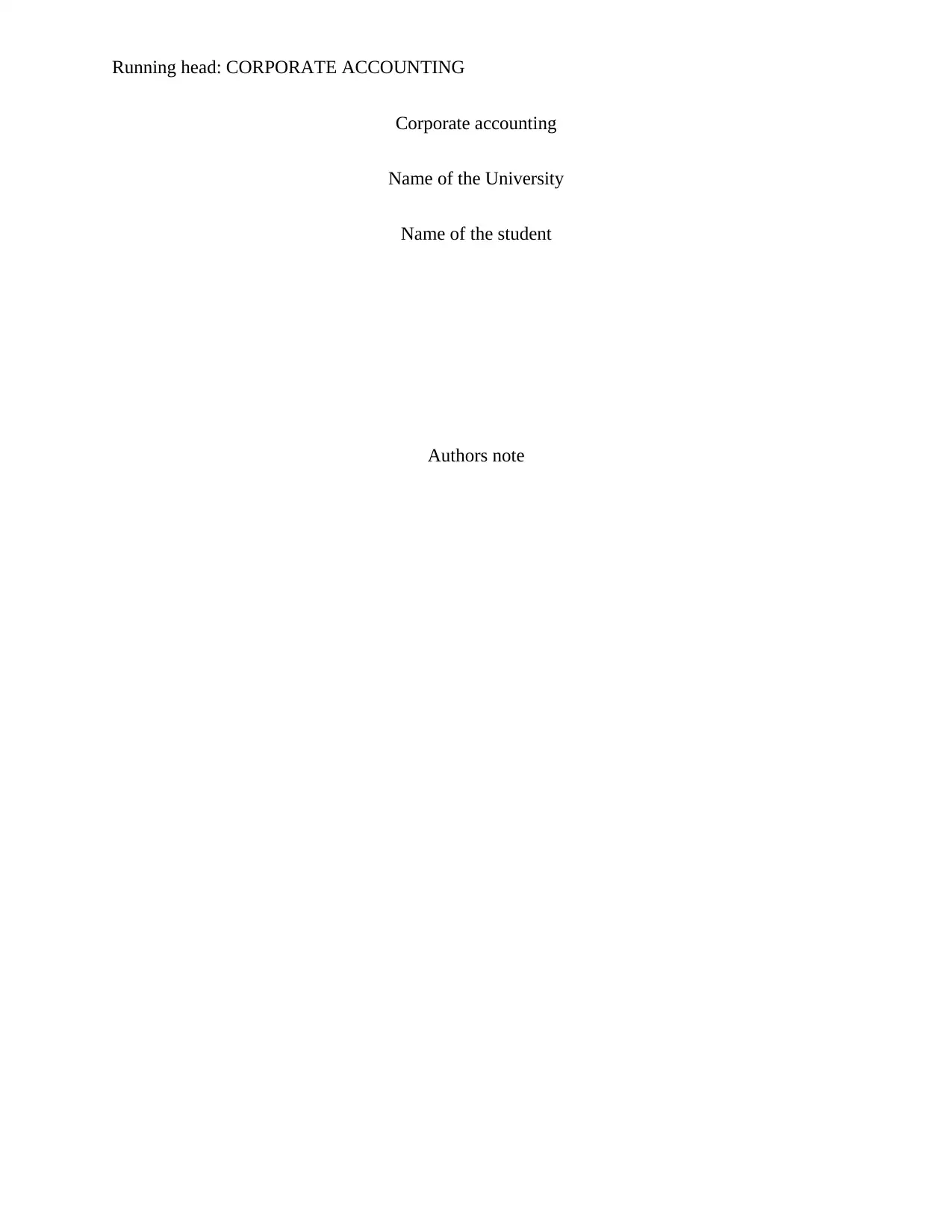
Running head: CORPORATE ACCOUNTING
Corporate accounting
Name of the University
Name of the student
Authors note
Corporate accounting
Name of the University
Name of the student
Authors note
Paraphrase This Document
Need a fresh take? Get an instant paraphrase of this document with our AI Paraphraser
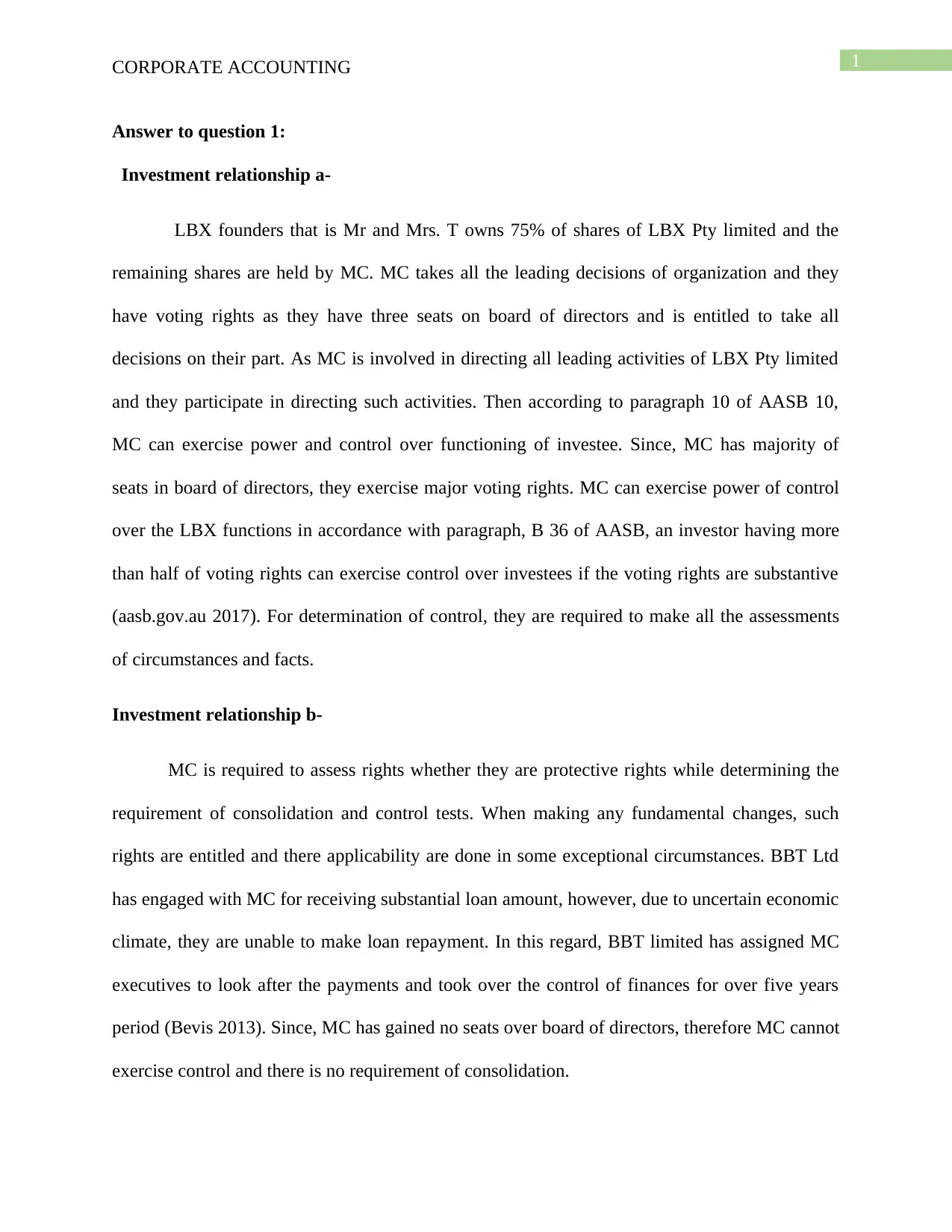
1CORPORATE ACCOUNTING
Answer to question 1:
Investment relationship a-
LBX founders that is Mr and Mrs. T owns 75% of shares of LBX Pty limited and the
remaining shares are held by MC. MC takes all the leading decisions of organization and they
have voting rights as they have three seats on board of directors and is entitled to take all
decisions on their part. As MC is involved in directing all leading activities of LBX Pty limited
and they participate in directing such activities. Then according to paragraph 10 of AASB 10,
MC can exercise power and control over functioning of investee. Since, MC has majority of
seats in board of directors, they exercise major voting rights. MC can exercise power of control
over the LBX functions in accordance with paragraph, B 36 of AASB, an investor having more
than half of voting rights can exercise control over investees if the voting rights are substantive
(aasb.gov.au 2017). For determination of control, they are required to make all the assessments
of circumstances and facts.
Investment relationship b-
MC is required to assess rights whether they are protective rights while determining the
requirement of consolidation and control tests. When making any fundamental changes, such
rights are entitled and there applicability are done in some exceptional circumstances. BBT Ltd
has engaged with MC for receiving substantial loan amount, however, due to uncertain economic
climate, they are unable to make loan repayment. In this regard, BBT limited has assigned MC
executives to look after the payments and took over the control of finances for over five years
period (Bevis 2013). Since, MC has gained no seats over board of directors, therefore MC cannot
exercise control and there is no requirement of consolidation.
Answer to question 1:
Investment relationship a-
LBX founders that is Mr and Mrs. T owns 75% of shares of LBX Pty limited and the
remaining shares are held by MC. MC takes all the leading decisions of organization and they
have voting rights as they have three seats on board of directors and is entitled to take all
decisions on their part. As MC is involved in directing all leading activities of LBX Pty limited
and they participate in directing such activities. Then according to paragraph 10 of AASB 10,
MC can exercise power and control over functioning of investee. Since, MC has majority of
seats in board of directors, they exercise major voting rights. MC can exercise power of control
over the LBX functions in accordance with paragraph, B 36 of AASB, an investor having more
than half of voting rights can exercise control over investees if the voting rights are substantive
(aasb.gov.au 2017). For determination of control, they are required to make all the assessments
of circumstances and facts.
Investment relationship b-
MC is required to assess rights whether they are protective rights while determining the
requirement of consolidation and control tests. When making any fundamental changes, such
rights are entitled and there applicability are done in some exceptional circumstances. BBT Ltd
has engaged with MC for receiving substantial loan amount, however, due to uncertain economic
climate, they are unable to make loan repayment. In this regard, BBT limited has assigned MC
executives to look after the payments and took over the control of finances for over five years
period (Bevis 2013). Since, MC has gained no seats over board of directors, therefore MC cannot
exercise control and there is no requirement of consolidation.
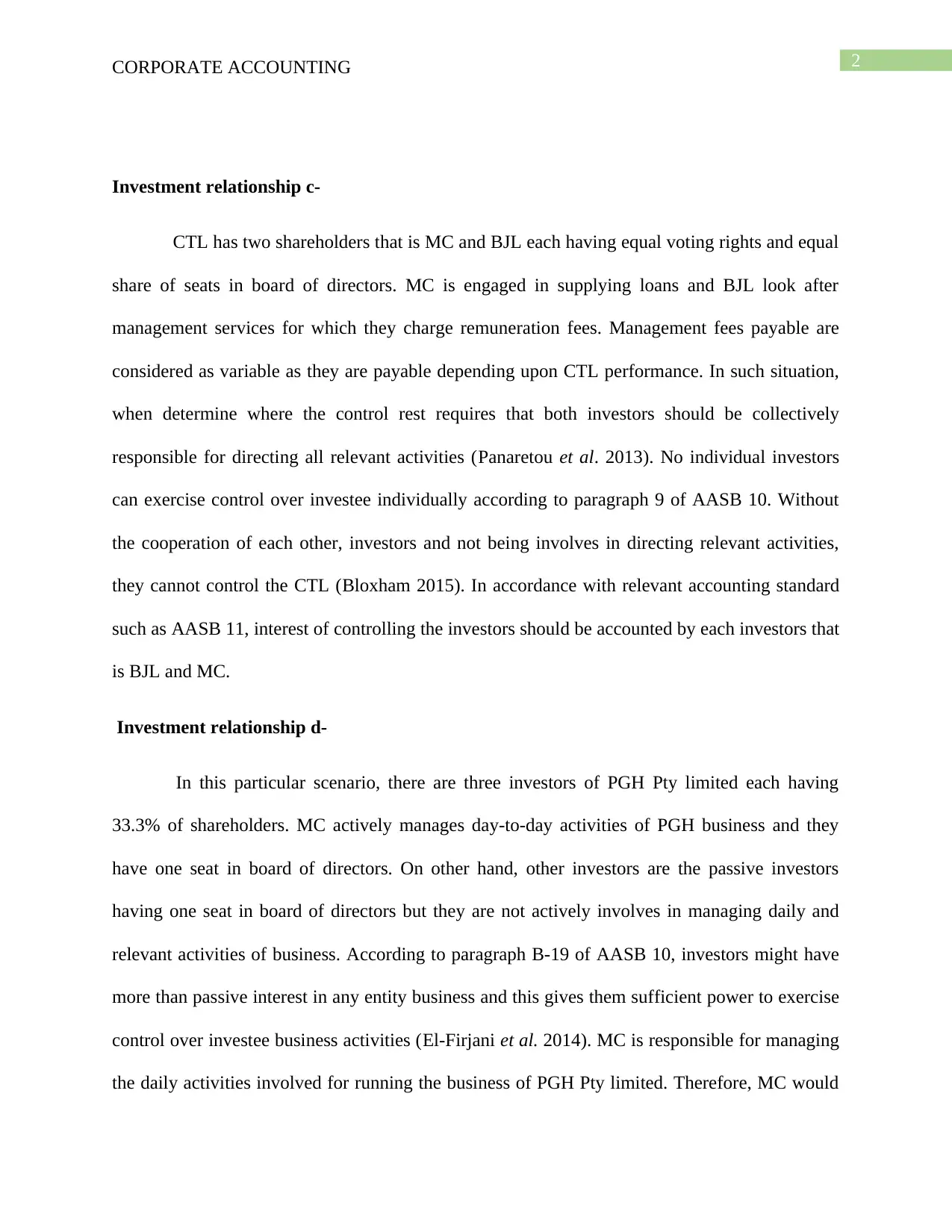
2CORPORATE ACCOUNTING
Investment relationship c-
CTL has two shareholders that is MC and BJL each having equal voting rights and equal
share of seats in board of directors. MC is engaged in supplying loans and BJL look after
management services for which they charge remuneration fees. Management fees payable are
considered as variable as they are payable depending upon CTL performance. In such situation,
when determine where the control rest requires that both investors should be collectively
responsible for directing all relevant activities (Panaretou et al. 2013). No individual investors
can exercise control over investee individually according to paragraph 9 of AASB 10. Without
the cooperation of each other, investors and not being involves in directing relevant activities,
they cannot control the CTL (Bloxham 2015). In accordance with relevant accounting standard
such as AASB 11, interest of controlling the investors should be accounted by each investors that
is BJL and MC.
Investment relationship d-
In this particular scenario, there are three investors of PGH Pty limited each having
33.3% of shareholders. MC actively manages day-to-day activities of PGH business and they
have one seat in board of directors. On other hand, other investors are the passive investors
having one seat in board of directors but they are not actively involves in managing daily and
relevant activities of business. According to paragraph B-19 of AASB 10, investors might have
more than passive interest in any entity business and this gives them sufficient power to exercise
control over investee business activities (El-Firjani et al. 2014). MC is responsible for managing
the daily activities involved for running the business of PGH Pty limited. Therefore, MC would
Investment relationship c-
CTL has two shareholders that is MC and BJL each having equal voting rights and equal
share of seats in board of directors. MC is engaged in supplying loans and BJL look after
management services for which they charge remuneration fees. Management fees payable are
considered as variable as they are payable depending upon CTL performance. In such situation,
when determine where the control rest requires that both investors should be collectively
responsible for directing all relevant activities (Panaretou et al. 2013). No individual investors
can exercise control over investee individually according to paragraph 9 of AASB 10. Without
the cooperation of each other, investors and not being involves in directing relevant activities,
they cannot control the CTL (Bloxham 2015). In accordance with relevant accounting standard
such as AASB 11, interest of controlling the investors should be accounted by each investors that
is BJL and MC.
Investment relationship d-
In this particular scenario, there are three investors of PGH Pty limited each having
33.3% of shareholders. MC actively manages day-to-day activities of PGH business and they
have one seat in board of directors. On other hand, other investors are the passive investors
having one seat in board of directors but they are not actively involves in managing daily and
relevant activities of business. According to paragraph B-19 of AASB 10, investors might have
more than passive interest in any entity business and this gives them sufficient power to exercise
control over investee business activities (El-Firjani et al. 2014). MC is responsible for managing
the daily activities involved for running the business of PGH Pty limited. Therefore, MC would
⊘ This is a preview!⊘
Do you want full access?
Subscribe today to unlock all pages.

Trusted by 1+ million students worldwide
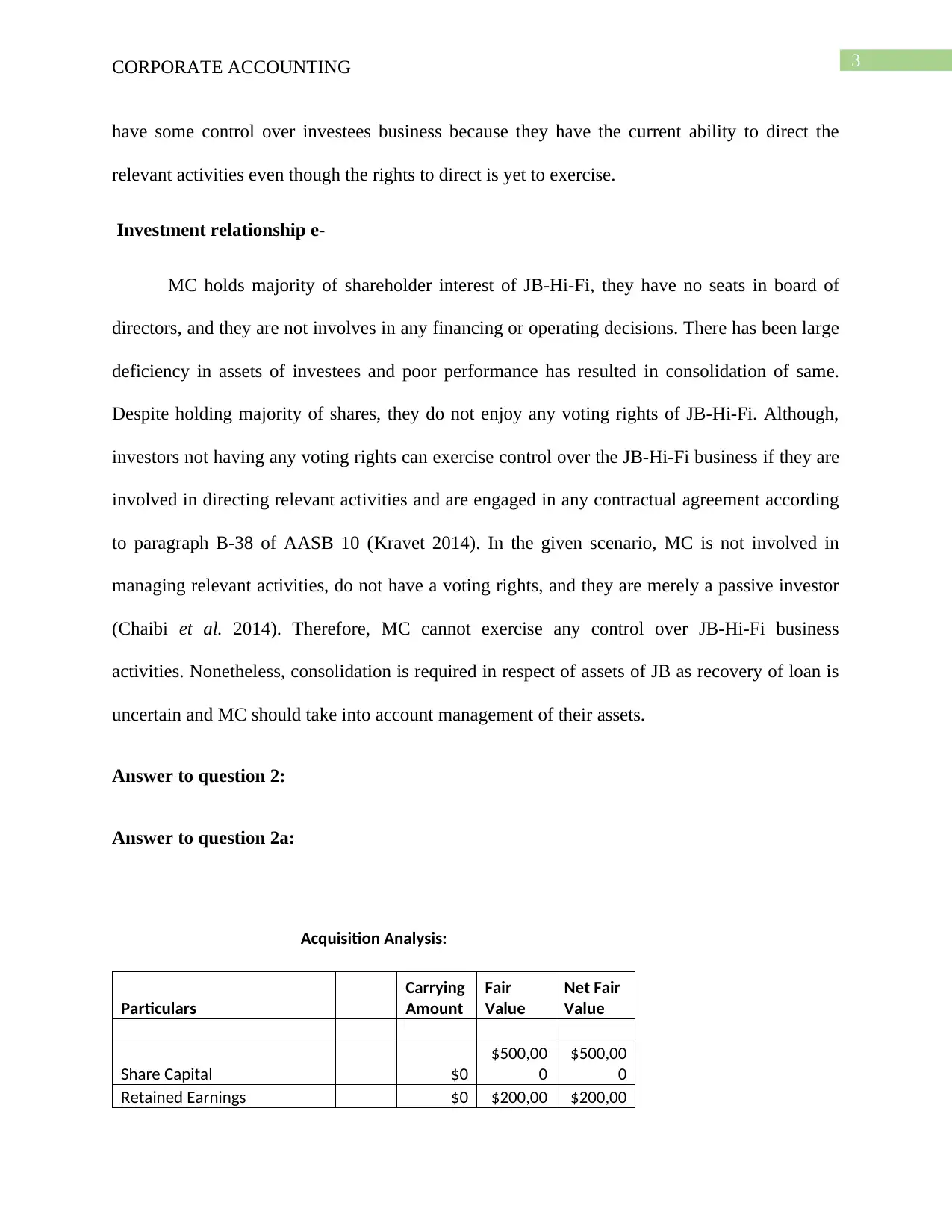
3CORPORATE ACCOUNTING
have some control over investees business because they have the current ability to direct the
relevant activities even though the rights to direct is yet to exercise.
Investment relationship e-
MC holds majority of shareholder interest of JB-Hi-Fi, they have no seats in board of
directors, and they are not involves in any financing or operating decisions. There has been large
deficiency in assets of investees and poor performance has resulted in consolidation of same.
Despite holding majority of shares, they do not enjoy any voting rights of JB-Hi-Fi. Although,
investors not having any voting rights can exercise control over the JB-Hi-Fi business if they are
involved in directing relevant activities and are engaged in any contractual agreement according
to paragraph B-38 of AASB 10 (Kravet 2014). In the given scenario, MC is not involved in
managing relevant activities, do not have a voting rights, and they are merely a passive investor
(Chaibi et al. 2014). Therefore, MC cannot exercise any control over JB-Hi-Fi business
activities. Nonetheless, consolidation is required in respect of assets of JB as recovery of loan is
uncertain and MC should take into account management of their assets.
Answer to question 2:
Answer to question 2a:
Acquisition Analysis:
Particulars
Carrying
Amount
Fair
Value
Net Fair
Value
Share Capital $0
$500,00
0
$500,00
0
Retained Earnings $0 $200,00 $200,00
have some control over investees business because they have the current ability to direct the
relevant activities even though the rights to direct is yet to exercise.
Investment relationship e-
MC holds majority of shareholder interest of JB-Hi-Fi, they have no seats in board of
directors, and they are not involves in any financing or operating decisions. There has been large
deficiency in assets of investees and poor performance has resulted in consolidation of same.
Despite holding majority of shares, they do not enjoy any voting rights of JB-Hi-Fi. Although,
investors not having any voting rights can exercise control over the JB-Hi-Fi business if they are
involved in directing relevant activities and are engaged in any contractual agreement according
to paragraph B-38 of AASB 10 (Kravet 2014). In the given scenario, MC is not involved in
managing relevant activities, do not have a voting rights, and they are merely a passive investor
(Chaibi et al. 2014). Therefore, MC cannot exercise any control over JB-Hi-Fi business
activities. Nonetheless, consolidation is required in respect of assets of JB as recovery of loan is
uncertain and MC should take into account management of their assets.
Answer to question 2:
Answer to question 2a:
Acquisition Analysis:
Particulars
Carrying
Amount
Fair
Value
Net Fair
Value
Share Capital $0
$500,00
0
$500,00
0
Retained Earnings $0 $200,00 $200,00
Paraphrase This Document
Need a fresh take? Get an instant paraphrase of this document with our AI Paraphraser
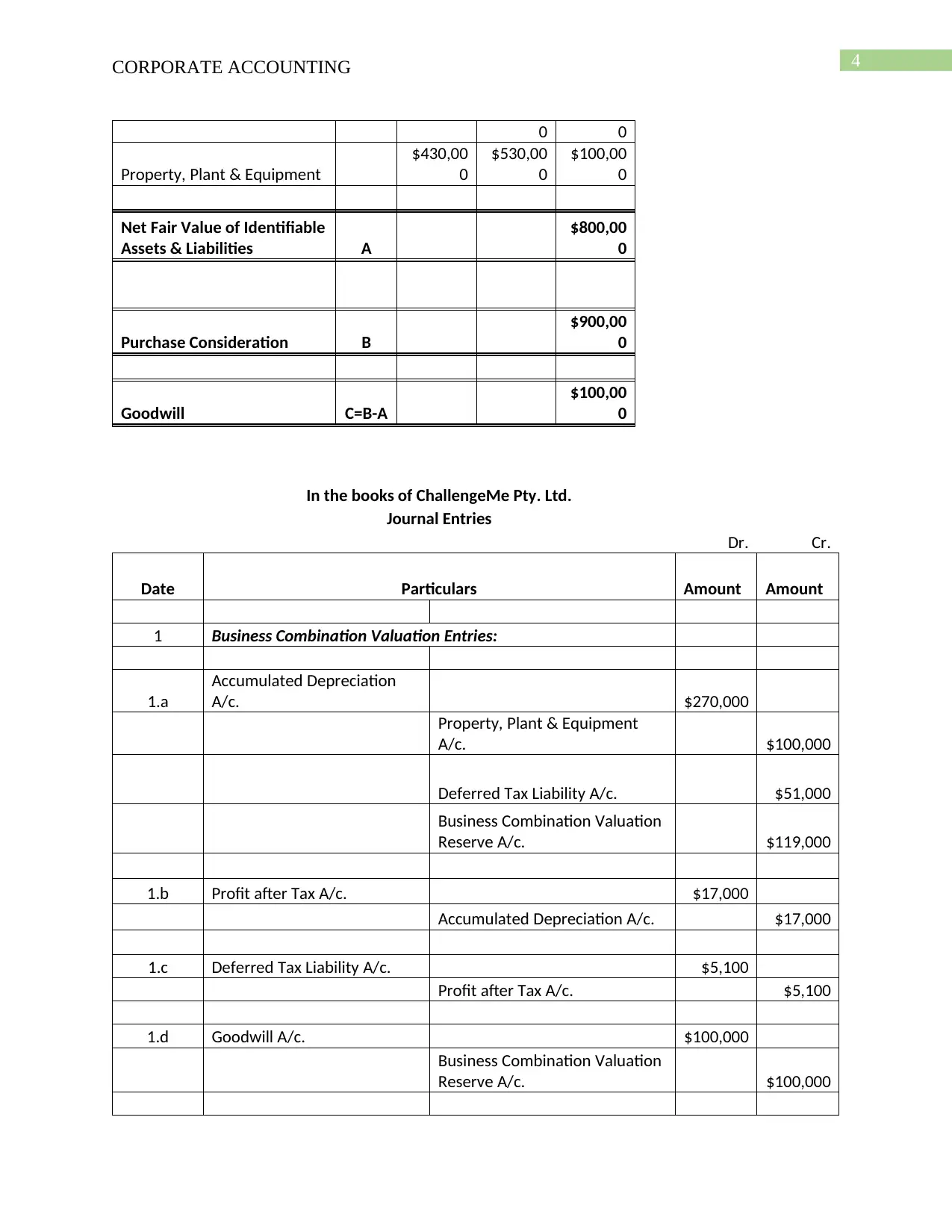
4CORPORATE ACCOUNTING
0 0
Property, Plant & Equipment
$430,00
0
$530,00
0
$100,00
0
Net Fair Value of Identifiable
Assets & Liabilities A
$800,00
0
Purchase Consideration B
$900,00
0
Goodwill C=B-A
$100,00
0
In the books of ChallengeMe Pty. Ltd.
Journal Entries
Dr. Cr.
Date Particulars Amount Amount
1 Business Combination Valuation Entries:
1.a
Accumulated Depreciation
A/c. $270,000
Property, Plant & Equipment
A/c. $100,000
Deferred Tax Liability A/c. $51,000
Business Combination Valuation
Reserve A/c. $119,000
1.b Profit after Tax A/c. $17,000
Accumulated Depreciation A/c. $17,000
1.c Deferred Tax Liability A/c. $5,100
Profit after Tax A/c. $5,100
1.d Goodwill A/c. $100,000
Business Combination Valuation
Reserve A/c. $100,000
0 0
Property, Plant & Equipment
$430,00
0
$530,00
0
$100,00
0
Net Fair Value of Identifiable
Assets & Liabilities A
$800,00
0
Purchase Consideration B
$900,00
0
Goodwill C=B-A
$100,00
0
In the books of ChallengeMe Pty. Ltd.
Journal Entries
Dr. Cr.
Date Particulars Amount Amount
1 Business Combination Valuation Entries:
1.a
Accumulated Depreciation
A/c. $270,000
Property, Plant & Equipment
A/c. $100,000
Deferred Tax Liability A/c. $51,000
Business Combination Valuation
Reserve A/c. $119,000
1.b Profit after Tax A/c. $17,000
Accumulated Depreciation A/c. $17,000
1.c Deferred Tax Liability A/c. $5,100
Profit after Tax A/c. $5,100
1.d Goodwill A/c. $100,000
Business Combination Valuation
Reserve A/c. $100,000
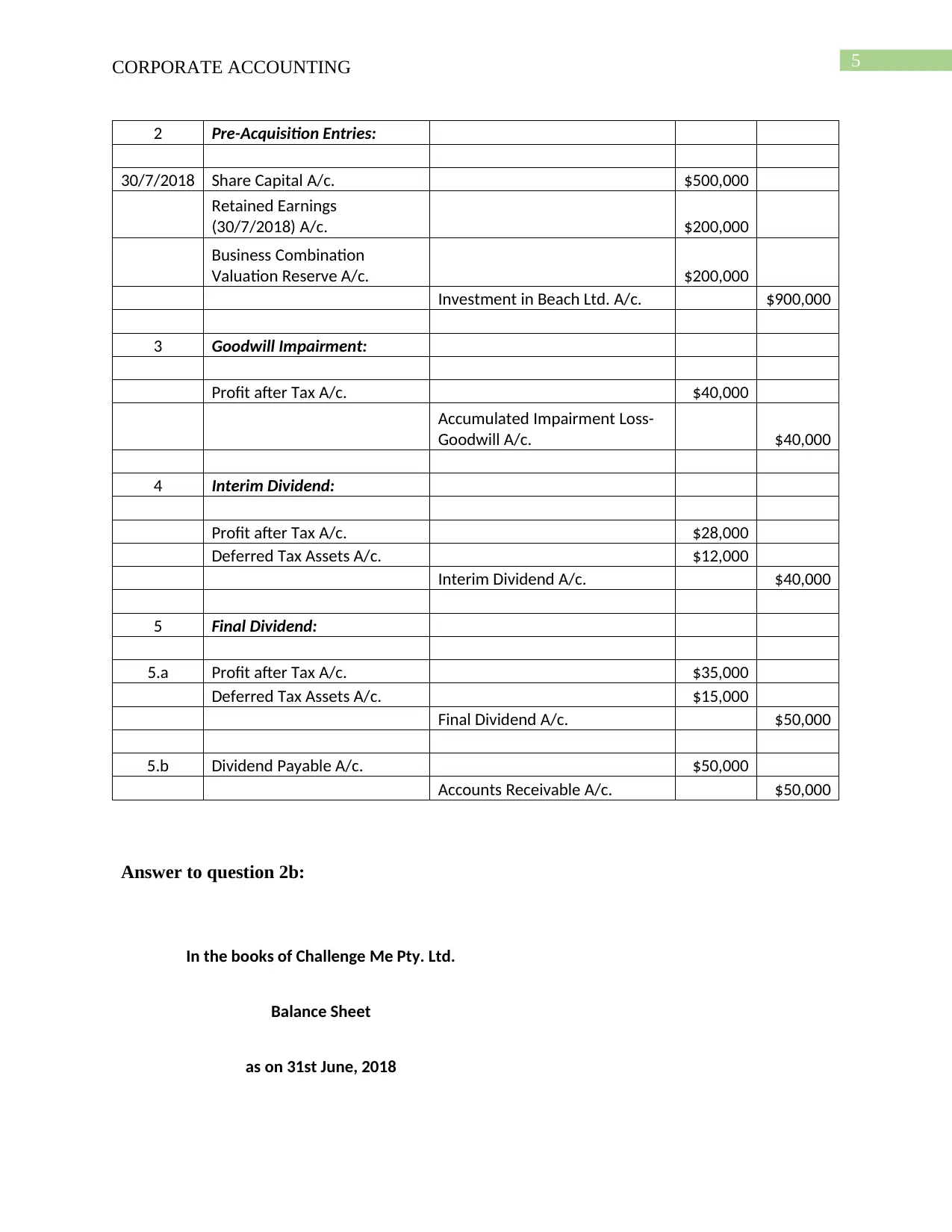
5CORPORATE ACCOUNTING
2 Pre-Acquisition Entries:
30/7/2018 Share Capital A/c. $500,000
Retained Earnings
(30/7/2018) A/c. $200,000
Business Combination
Valuation Reserve A/c. $200,000
Investment in Beach Ltd. A/c. $900,000
3 Goodwill Impairment:
Profit after Tax A/c. $40,000
Accumulated Impairment Loss-
Goodwill A/c. $40,000
4 Interim Dividend:
Profit after Tax A/c. $28,000
Deferred Tax Assets A/c. $12,000
Interim Dividend A/c. $40,000
5 Final Dividend:
5.a Profit after Tax A/c. $35,000
Deferred Tax Assets A/c. $15,000
Final Dividend A/c. $50,000
5.b Dividend Payable A/c. $50,000
Accounts Receivable A/c. $50,000
Answer to question 2b:
In the books of Challenge Me Pty. Ltd.
Balance Sheet
as on 31st June, 2018
2 Pre-Acquisition Entries:
30/7/2018 Share Capital A/c. $500,000
Retained Earnings
(30/7/2018) A/c. $200,000
Business Combination
Valuation Reserve A/c. $200,000
Investment in Beach Ltd. A/c. $900,000
3 Goodwill Impairment:
Profit after Tax A/c. $40,000
Accumulated Impairment Loss-
Goodwill A/c. $40,000
4 Interim Dividend:
Profit after Tax A/c. $28,000
Deferred Tax Assets A/c. $12,000
Interim Dividend A/c. $40,000
5 Final Dividend:
5.a Profit after Tax A/c. $35,000
Deferred Tax Assets A/c. $15,000
Final Dividend A/c. $50,000
5.b Dividend Payable A/c. $50,000
Accounts Receivable A/c. $50,000
Answer to question 2b:
In the books of Challenge Me Pty. Ltd.
Balance Sheet
as on 31st June, 2018
⊘ This is a preview!⊘
Do you want full access?
Subscribe today to unlock all pages.

Trusted by 1+ million students worldwide
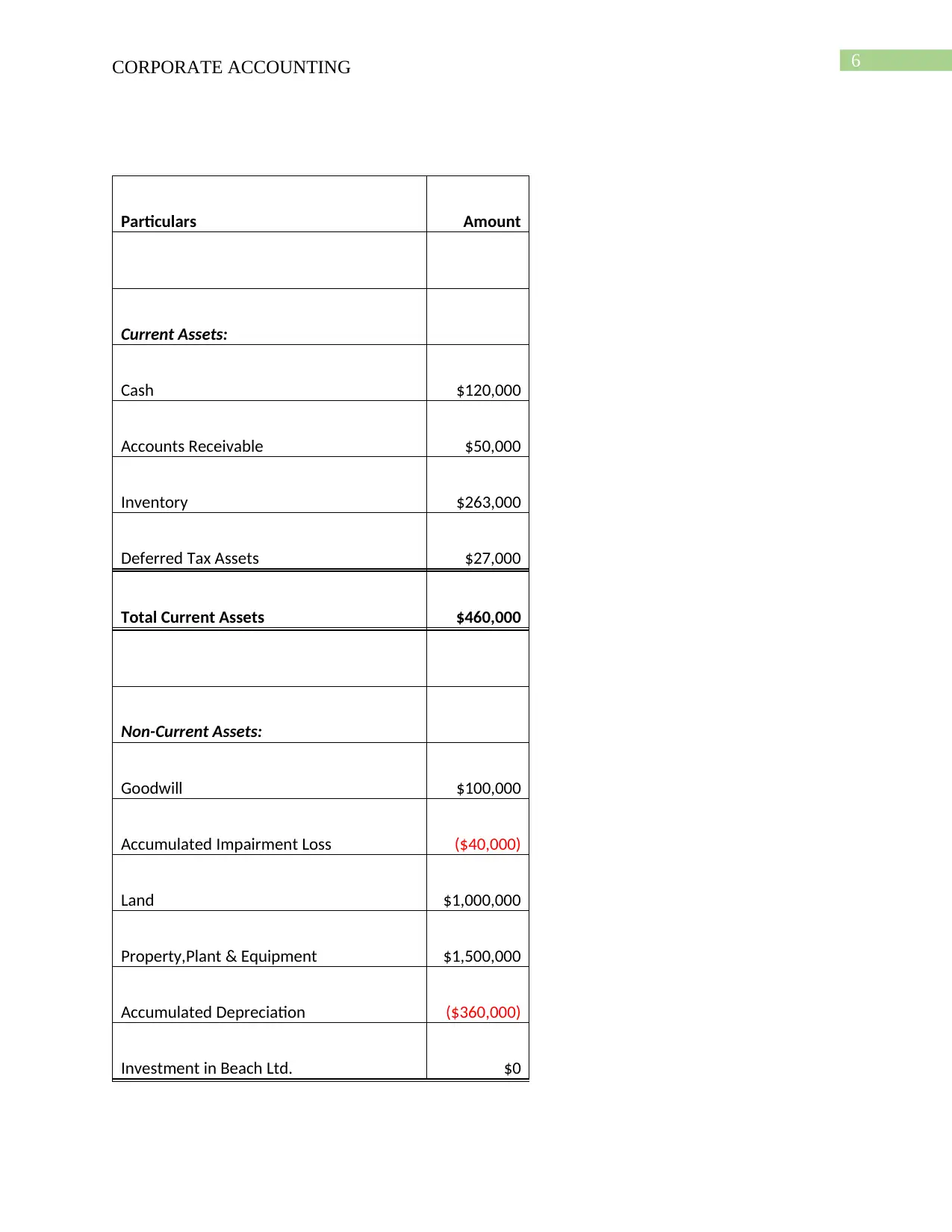
6CORPORATE ACCOUNTING
Particulars Amount
Current Assets:
Cash $120,000
Accounts Receivable $50,000
Inventory $263,000
Deferred Tax Assets $27,000
Total Current Assets $460,000
Non-Current Assets:
Goodwill $100,000
Accumulated Impairment Loss ($40,000)
Land $1,000,000
Property,Plant & Equipment $1,500,000
Accumulated Depreciation ($360,000)
Investment in Beach Ltd. $0
Particulars Amount
Current Assets:
Cash $120,000
Accounts Receivable $50,000
Inventory $263,000
Deferred Tax Assets $27,000
Total Current Assets $460,000
Non-Current Assets:
Goodwill $100,000
Accumulated Impairment Loss ($40,000)
Land $1,000,000
Property,Plant & Equipment $1,500,000
Accumulated Depreciation ($360,000)
Investment in Beach Ltd. $0
Paraphrase This Document
Need a fresh take? Get an instant paraphrase of this document with our AI Paraphraser
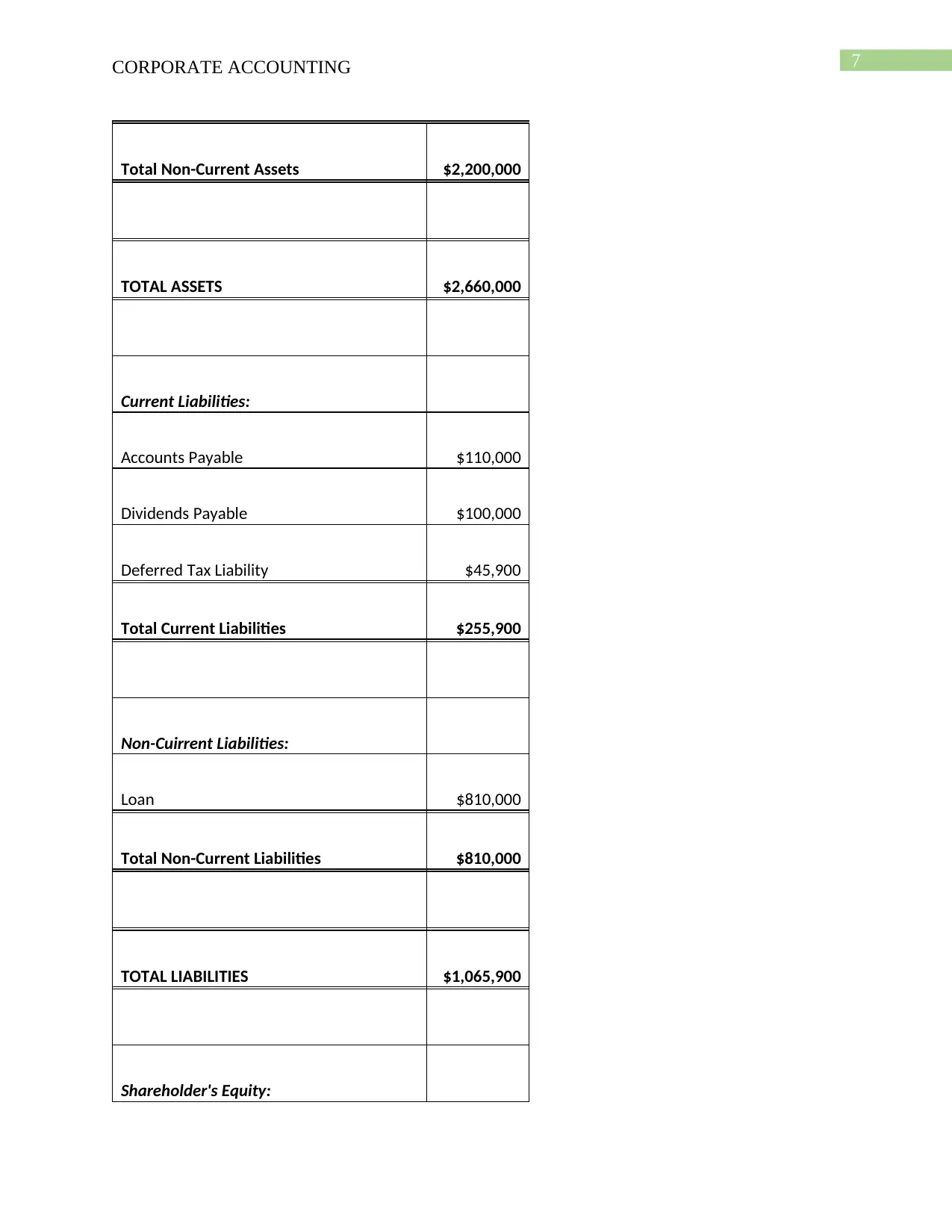
7CORPORATE ACCOUNTING
Total Non-Current Assets $2,200,000
TOTAL ASSETS $2,660,000
Current Liabilities:
Accounts Payable $110,000
Dividends Payable $100,000
Deferred Tax Liability $45,900
Total Current Liabilities $255,900
Non-Cuirrent Liabilities:
Loan $810,000
Total Non-Current Liabilities $810,000
TOTAL LIABILITIES $1,065,900
Shareholder's Equity:
Total Non-Current Assets $2,200,000
TOTAL ASSETS $2,660,000
Current Liabilities:
Accounts Payable $110,000
Dividends Payable $100,000
Deferred Tax Liability $45,900
Total Current Liabilities $255,900
Non-Cuirrent Liabilities:
Loan $810,000
Total Non-Current Liabilities $810,000
TOTAL LIABILITIES $1,065,900
Shareholder's Equity:
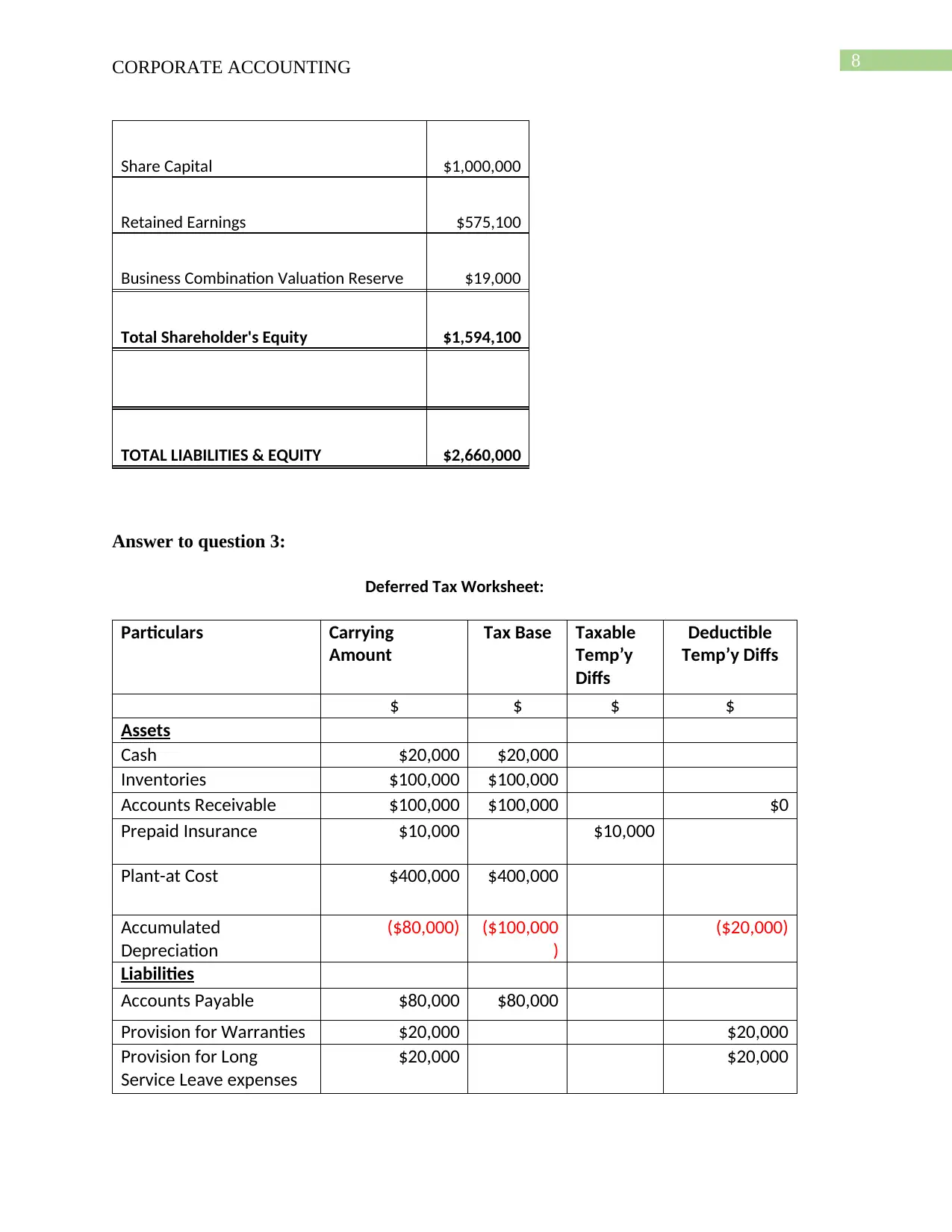
8CORPORATE ACCOUNTING
Share Capital $1,000,000
Retained Earnings $575,100
Business Combination Valuation Reserve $19,000
Total Shareholder's Equity $1,594,100
TOTAL LIABILITIES & EQUITY $2,660,000
Answer to question 3:
Deferred Tax Worksheet:
Particulars Carrying
Amount
Tax Base Taxable
Temp’y
Diffs
Deductible
Temp’y Diffs
$ $ $ $
Assets
Cash $20,000 $20,000
Inventories $100,000 $100,000
Accounts Receivable $100,000 $100,000 $0
Prepaid Insurance $10,000 $10,000
Plant-at Cost $400,000 $400,000
Accumulated
Depreciation
($80,000) ($100,000
)
($20,000)
Liabilities
Accounts Payable $80,000 $80,000
Provision for Warranties $20,000 $20,000
Provision for Long
Service Leave expenses
$20,000 $20,000
Share Capital $1,000,000
Retained Earnings $575,100
Business Combination Valuation Reserve $19,000
Total Shareholder's Equity $1,594,100
TOTAL LIABILITIES & EQUITY $2,660,000
Answer to question 3:
Deferred Tax Worksheet:
Particulars Carrying
Amount
Tax Base Taxable
Temp’y
Diffs
Deductible
Temp’y Diffs
$ $ $ $
Assets
Cash $20,000 $20,000
Inventories $100,000 $100,000
Accounts Receivable $100,000 $100,000 $0
Prepaid Insurance $10,000 $10,000
Plant-at Cost $400,000 $400,000
Accumulated
Depreciation
($80,000) ($100,000
)
($20,000)
Liabilities
Accounts Payable $80,000 $80,000
Provision for Warranties $20,000 $20,000
Provision for Long
Service Leave expenses
$20,000 $20,000
⊘ This is a preview!⊘
Do you want full access?
Subscribe today to unlock all pages.

Trusted by 1+ million students worldwide
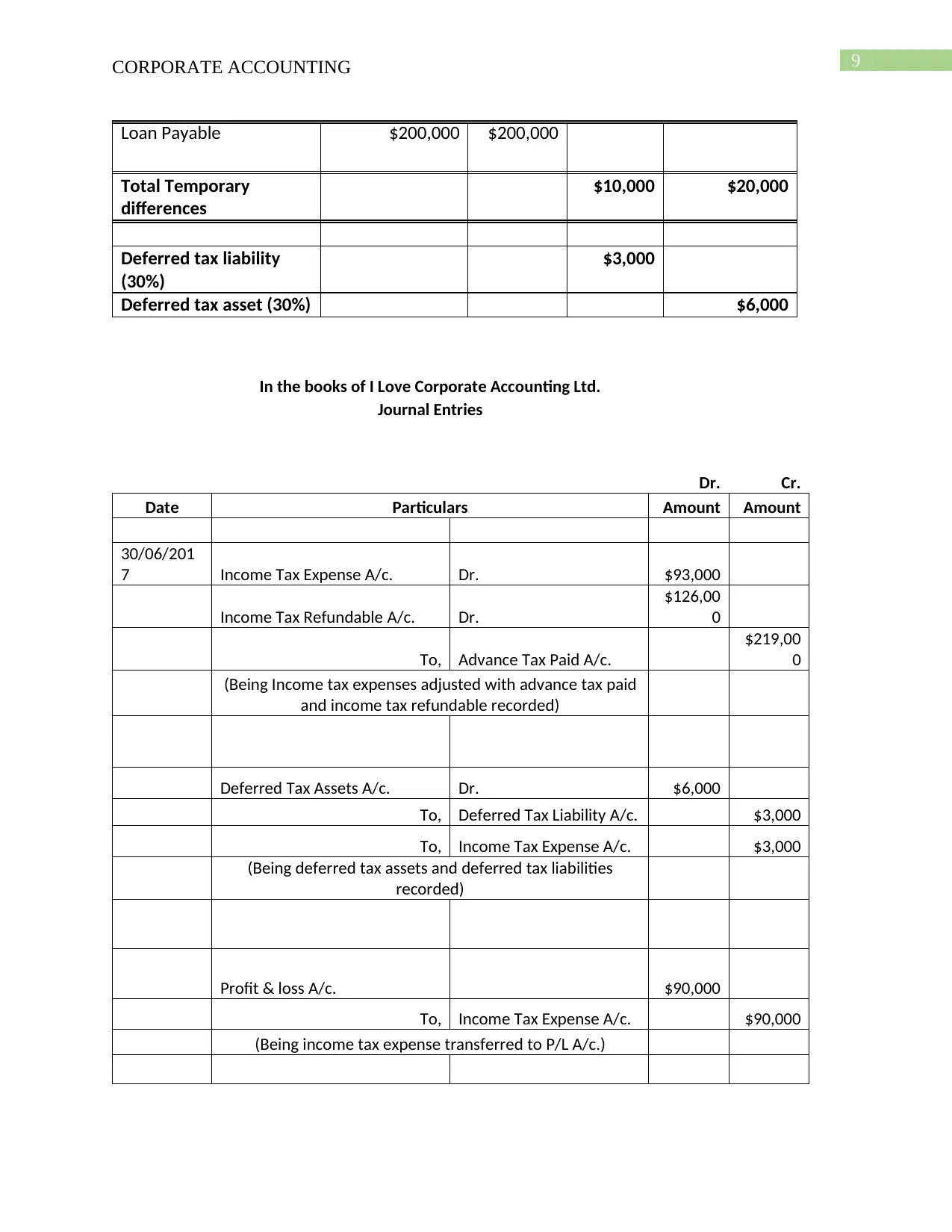
9CORPORATE ACCOUNTING
Loan Payable $200,000 $200,000
Total Temporary
differences
$10,000 $20,000
Deferred tax liability
(30%)
$3,000
Deferred tax asset (30%) $6,000
In the books of I Love Corporate Accounting Ltd.
Journal Entries
Dr. Cr.
Date Particulars Amount Amount
30/06/201
7 Income Tax Expense A/c. Dr. $93,000
Income Tax Refundable A/c. Dr.
$126,00
0
To, Advance Tax Paid A/c.
$219,00
0
(Being Income tax expenses adjusted with advance tax paid
and income tax refundable recorded)
Deferred Tax Assets A/c. Dr. $6,000
To, Deferred Tax Liability A/c. $3,000
To, Income Tax Expense A/c. $3,000
(Being deferred tax assets and deferred tax liabilities
recorded)
Profit & loss A/c. $90,000
To, Income Tax Expense A/c. $90,000
(Being income tax expense transferred to P/L A/c.)
Loan Payable $200,000 $200,000
Total Temporary
differences
$10,000 $20,000
Deferred tax liability
(30%)
$3,000
Deferred tax asset (30%) $6,000
In the books of I Love Corporate Accounting Ltd.
Journal Entries
Dr. Cr.
Date Particulars Amount Amount
30/06/201
7 Income Tax Expense A/c. Dr. $93,000
Income Tax Refundable A/c. Dr.
$126,00
0
To, Advance Tax Paid A/c.
$219,00
0
(Being Income tax expenses adjusted with advance tax paid
and income tax refundable recorded)
Deferred Tax Assets A/c. Dr. $6,000
To, Deferred Tax Liability A/c. $3,000
To, Income Tax Expense A/c. $3,000
(Being deferred tax assets and deferred tax liabilities
recorded)
Profit & loss A/c. $90,000
To, Income Tax Expense A/c. $90,000
(Being income tax expense transferred to P/L A/c.)
Paraphrase This Document
Need a fresh take? Get an instant paraphrase of this document with our AI Paraphraser
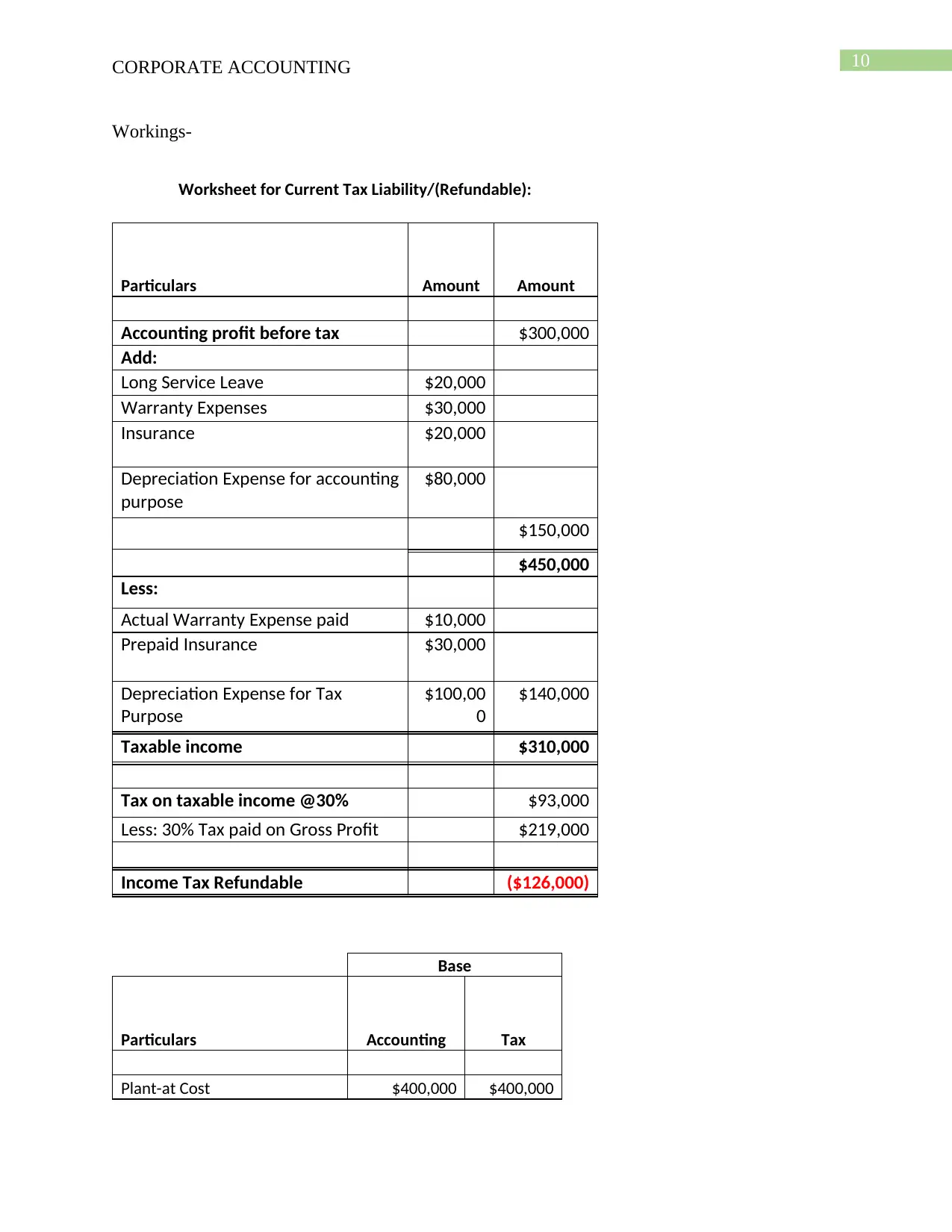
10CORPORATE ACCOUNTING
Workings-
Worksheet for Current Tax Liability/(Refundable):
Particulars Amount Amount
Accounting profit before tax $300,000
Add:
Long Service Leave $20,000
Warranty Expenses $30,000
Insurance $20,000
Depreciation Expense for accounting
purpose
$80,000
$150,000
$450,000
Less:
Actual Warranty Expense paid $10,000
Prepaid Insurance $30,000
Depreciation Expense for Tax
Purpose
$100,00
0
$140,000
Taxable income $310,000
Tax on taxable income @30% $93,000
Less: 30% Tax paid on Gross Profit $219,000
Income Tax Refundable ($126,000)
Base
Particulars Accounting Tax
Plant-at Cost $400,000 $400,000
Workings-
Worksheet for Current Tax Liability/(Refundable):
Particulars Amount Amount
Accounting profit before tax $300,000
Add:
Long Service Leave $20,000
Warranty Expenses $30,000
Insurance $20,000
Depreciation Expense for accounting
purpose
$80,000
$150,000
$450,000
Less:
Actual Warranty Expense paid $10,000
Prepaid Insurance $30,000
Depreciation Expense for Tax
Purpose
$100,00
0
$140,000
Taxable income $310,000
Tax on taxable income @30% $93,000
Less: 30% Tax paid on Gross Profit $219,000
Income Tax Refundable ($126,000)
Base
Particulars Accounting Tax
Plant-at Cost $400,000 $400,000

11CORPORATE ACCOUNTING
Useful Life (in years) 5 4
Depreciation Expenses p.a. $80,000 $100,000
Period of Utilization (in years) 1 1
Accumulated Depreciation $80,000 $100,000
Equipment (net Value) $320,000 $300,000
Answer to question 4:
Requirement a:
This particular question is about case of acquisition where 70% of shares of Wiley Plus
ltd are acquired by Wiley and sons, Australia limited. Here, acquisition is done by acquiring
equity interests. Under such scenario, goodwill can be calculated at the acquisition date of fair
value of acquiree’s interest rate. It does not make use of transferred equity interest. Valuation
technique can be used for determining the equity interest of fair value at the date of acquisition
(Ernstberger and Prott 2016).
Requirement b:
In relationship to additional ownership of interest acquired, goodwill can be realized by
making fair value adjustments. The impairment loss is deducted from assets value recognized at
acquisition date (Christensen et al. 2013).
Requirement c:
Useful Life (in years) 5 4
Depreciation Expenses p.a. $80,000 $100,000
Period of Utilization (in years) 1 1
Accumulated Depreciation $80,000 $100,000
Equipment (net Value) $320,000 $300,000
Answer to question 4:
Requirement a:
This particular question is about case of acquisition where 70% of shares of Wiley Plus
ltd are acquired by Wiley and sons, Australia limited. Here, acquisition is done by acquiring
equity interests. Under such scenario, goodwill can be calculated at the acquisition date of fair
value of acquiree’s interest rate. It does not make use of transferred equity interest. Valuation
technique can be used for determining the equity interest of fair value at the date of acquisition
(Ernstberger and Prott 2016).
Requirement b:
In relationship to additional ownership of interest acquired, goodwill can be realized by
making fair value adjustments. The impairment loss is deducted from assets value recognized at
acquisition date (Christensen et al. 2013).
Requirement c:
⊘ This is a preview!⊘
Do you want full access?
Subscribe today to unlock all pages.

Trusted by 1+ million students worldwide
1 out of 19
Related Documents
Your All-in-One AI-Powered Toolkit for Academic Success.
+13062052269
info@desklib.com
Available 24*7 on WhatsApp / Email
![[object Object]](/_next/static/media/star-bottom.7253800d.svg)
Unlock your academic potential
Copyright © 2020–2025 A2Z Services. All Rights Reserved. Developed and managed by ZUCOL.





